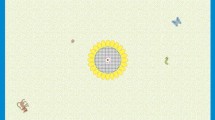Abstract
Exact knowledge of the normal variation of visual fields and the influence of age upon them is essential to differentiate normal from abnormal results, e.g., in glaucoma suspects. This study evaluates the normal variability of differential light sensitivity at individual test locations and incorporates a data base of a multicenter study performed with Octopus 201 perimeters using Program G1. The 824 fields thus obtained included 139 fields of 139 healthy volunteers who had undergone two previous visual fields and completed all three phases of the program. Sensitivity decreased linearly with age, an effect which for individual test locations ranged between 0.036 and 0.107 dB/year and which became more pronounced towards the periphery. On average, the age-related effects explained only 17% of the interindividual variation (range 4%–31%). The interindividual variation within a test averaged 4.6 dB2 and revealed a moderate, but quadratic increase towards the periphery. The intra-individual short-term variation was considerably lower, averaging 2.2 dB2. There was a similar modest, quadratic increase of the intra-individual variation towards the periphery. The results may help distinguish incipient disease manifestations from normal variation of perimetric results. Furthermore, the results give insight into the calculation of global visual field indices.
Similar content being viewed by others
References
Anderson DR, Feuer WJ, Alward WLM, Skuta GL (1989) Threshold equivalence between perimeters. Am J Ophthalmol 107:493–505
Bebie H (1985) Computerized techniques of threshold determination. In: Whalen WR, Spaeth GL (eds) Computerized visual fields: what they are and how to use them. Slack, Thorofare, NJ, pp 29–44
Bebie H, Flammer J, Bebié (1990) The cumulative defect curve: separation of local and diffuse components of the visual field damage. Graefe's Arch Clin Exp Ophthalmol 227:9–12
Bebie H, Fankhauser F, Spahr J (1976) Static perimetry: strategies. Acta Ophthalmol 54:325–338
Bebie H, Fankhauser F, Spahr J (1976) Static perimetry: accuracy and fluctuations. Acta Ophthalmol 54:339–348
Brenton RS, Phelps CD (1986) The normal visual field in the Humphrey Field Analyzer. Ophthalmologica 193:56–74
Dumbleton KA, Flanagan JG, Trope GE, Coyle E (1992) A fast strategy for threshold estimation in glaucoma. Invest Ophthalmol Vis Sci 33:1387
Fankhauser F (1979) Problems related to the design of automatic perimeters. III. The display and interpretation of perimetric results by automated methods. Doc Ophthalmol 47:113–121
Fankhauser F, Koch P, Roulier A (1972) On automation of perimetry. Graefe's Arch Clin Exp Ophthalmol 187:126–150
Flammer J (1986) The concepts of visual field indices. Graefe's Arch Clin Exp Ophthalmol 224:389–392
Flammer J, Zulauf M (1985) The frequency distribution of the deviations in static perimetry. Doc Ophthalmol Proc Ser 42:17–24
Flammer J, Drance SM, Fankhauser F, Augustiny L (1984) Differential light threshold in automated static perimetry. Factors influencing short-term fluctuation. Arch Ophthalmol 102:876–879
Flammer J, Drance SM, Augustiny L, Funkhouser A (1985) Quantificatof glaucomatous visual field defects with automated perimetry. Invest Ophthalmol Vis Sci 26:176–181
Flammer J, Jenni F, Bebié H, Keller B (1987) The Octopus glaucoma program G1. Glaucoma 9:67–72
Haas A, Hammer J, Schneider U (1986) Influence of age on the visual fields of normal subjects. Am J Ophthalmol 101:199–203
Heijl A, Åsman P (1989) A clinical study of perimetric probability maps. Arch Ophthalmol 107 (2): 199–203
Heijl A, Lindgren G, Olsson J (1987) Normal variability of static perimetric threshold values across the central visual field. Arch Ophthalmol 105:1544–1549
Heijl A, Lindgren G, Olsson J (1988) Perimetric threshold variability and age. Arch Ophthalmol 106:450–452
Hoskin HD, Migliazzo C (1985) Development of a visual field screening test using a Humphrey visual field analyzer. Doc Ophthalmol Proc Ser 42:85–90
Iwase A, Kitazawa Y, Ohno Y (1988) On age-related norms of the visual field. Jpn J Ophthalmol 32:429–437
Katz J, Sommer A (1986) Asymmetry and variation in the normal hill of vision. Arch Ophthalmol 104:165–168
Moss ID, Hudson C, Dengler-Harles M, Wild JM, Whitaker DJ, O'Neill EC (1992) A 3dB step single crossing algorithm for threshold automated perimetry. Invest Ophthalmol Vis Sci 33:969
Parrish RK II, Schiffman J, Anderson DR (1984) Static and kinetic visual field testing. Reproducibility in normal volunteers. Arch Ophthalmol 102:1497–1502
Rutishauser C, Flammer J (1988) Retests in static perimetry. Graefe's Arch Clin Exp Ophthalmol 226:75–77
Rutishauser C, Flammer J, Haas A (1989) The distribution of normal values in automated perimetry. Graefe's Arch Clin Exp Ophthalmol 227:513–517
Sues FE, Verriest G (1987) Inter- and intraindividual sensitivity variations with manual and automated static perimeters. Ophthalmologica 195:209–214
Zulauf M, Caprioli J (1991) Fluctuations of the visual field in glaucoma. Ophthalmic Clin North Am 4:671–697
Zulauf J, Caprioli J (1992) What constitutes progression of glaucomatous visual field defects? Semin Ophthalmol 7:130–146
Zulauf M, Caprioli M, Hoffman D (1991) Asymmetry of the visual field in a normal population. Invest Ophthalmol Vis Sci [Suppl] 32:1192
Zulauf M, LeBlanc RP, Flammer J (1994) Normal visual fields measured with Octopus Program GI. II. Global visual-field indices. Graefe's Arch Clin Exp Ophthalmol 232:516–522
Author information
Authors and Affiliations
Additional information
This study was carried out by the members of the G1 Normal Value Study Group. A list of participants appears at the end of the article.
Rights and permissions
About this article
Cite this article
Zulauf, M., Zulauf, M., Flammer, J. et al. Normal visual fields measured with Octopus Program G1. Graefe's Arch Clin Exp Ophthalmol 232, 509–515 (1994). https://doi.org/10.1007/BF00181992
Received:
Revised:
Accepted:
Issue Date:
DOI: https://doi.org/10.1007/BF00181992




